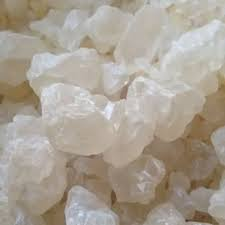In recent years, the global drug landscape has witnessed the rapid emergence of new psychoactive substances (NPS), often referred to as “designer drugs.” One such substance gaining attention in the scientific, medical, and law enforcement communities is Eutylone, commonly sold in crystal form and often misrepresented as MDMA or other recreational stimulants. Though relatively new, its impact has already raised serious concerns worldwide due to its potent effects, legal ambiguity, and health risks.
What is Eutylone?
Eutylone (chemical name: β-keto-1,3-benzodioxolyl-N-ethylbutanamine) is a synthetic stimulant of the cathinone class, a group of substances chemically related to the naturally occurring stimulant cathinone found in the khat plant. It is closely related to other synthetic cathinones like methylone, ethylone, and pentylone. These substances are known for their stimulant and empathogenic (empathy-producing) effects, making them attractive alternatives to MDMA (ecstasy) or cocaine.
Eutylone usually appears as a white or off-white crystal or powder and is typically ingested orally, snorted, or less commonly, smoked or injected.
Effects and Experience
The psychoactive effects of Eutylone are often described as similar to those of MDMA but shorter-lasting and less euphoric. Users report feelings of:
-
Increased energy and alertness
-
Enhanced sociability and talkativeness
-
Mild euphoria
-
Heightened sensory perception
However, these perceived benefits are frequently accompanied by negative effects, especially as the dose increases or when the drug wears off. These include:
-
Anxiety and paranoia
-
Elevated heart rate and blood pressure
-
Insomnia
-
Teeth grinding
-
Depression and mood swings during the comedown
Unlike MDMA, Eutylone’s effects tend to wear off faster, leading users to re-dose frequently—a behavior that significantly increases the risk of overdose and adverse reactions.
Health Risks and Dangers
-
Cardiovascular problems (e.g., tachycardia, hypertension)
-
Neurological effects (e.g., seizures, agitation, hallucinations)
-
Serotonin syndrome, particularly when mixed with other stimulants or antidepressants
-
Acute psychosis or aggressive behavior
-
Hyperthermia (overheating), which can be fatal if untreated
Deaths associated with Eutylone use have been reported, especially in cases where it was mixed with other drugs, either knowingly or unknowingly. Its resemblance to MDMA and similar substances makes it particularly dangerous when sold as a counterfeit pill or powder.
Legal Status
Eutylone exists in a legal gray area in many countries. As an emerging NPS, it may not be specifically listed in national drug schedules, allowing vendors to distribute it online or through underground markets under the guise of “research chemicals” or “bath salts.”
-
In the United States, Eutylone was temporarily classified as a Schedule I substance by the DEA in 2020 due to its high potential for abuse and lack of medical use.
-
In Europe, Eutylone is controlled under various national legislations, with some countries treating it as an analogue of other banned cathinones.
-
India, China, and other parts of Asia have also taken steps to restrict its distribution, although enforcement can be inconsistent.
Because the legislation often lags behind the appearance of new substances, Eutylone remains accessible to some extent on the darknet and illicit markets.
Eutylone in the Drug Market
One of the biggest concerns surrounding Eutylone is misrepresentation. It is often sold as MDMA, methylone, or ecstasy, especially in pressed pills or powdered form. This creates a serious risk for users who may take it unknowingly, expecting a different drug with a different potency and risk profile.
This trend reflects a broader issue in recreational drug use: the contamination or substitution of known drugs with newer, more dangerous analogs. Pill testing services and drug-checking labs have reported an increase in Eutylone-positive samples in recent years.
Harm Reduction and Safety
Given its unpredictable effects and the possibility of contamination or adulteration, the safest option is to avoid Eutylone altogether. However, if someone chooses to use, harm reduction strategies include:
-
Start with a very low dose: Due to variability in potency.
-
Avoid re-dosing: This increases the chance of side effects.
-
Do not mix with other substances: Especially alcohol, MDMA, or prescription medications.
-
Test your substance: Use reagent test kits or access a professional drug-checking service.
-
Stay cool and hydrated: But avoid excessive water intake, which can also be dangerous.
-
Never use alone: Have someone nearby in case of a medical emergency.
If someone experiences chest pain, extreme agitation, seizures, or hallucinations after taking a substance suspected to be Eutylone, seek medical attention immediately.
The rise of Eutylone crystal in the synthetic drug market is a stark reminder of how quickly new, dangerous substances can emerge. Its popularity stems partly from misrepresentation and legal loopholes, but the health risks are very real. Whether you're a concerned parent, health professional, or recreational user, understanding the dangers of Eutylone is critical to staying safe in today’s ever-changing drug environment.
Contact Us
WhatsApp:+86 171 0282 1847
Email:info@nitazenechems.com
Website: https://nitazenechems.com/



Comments
Post a Comment